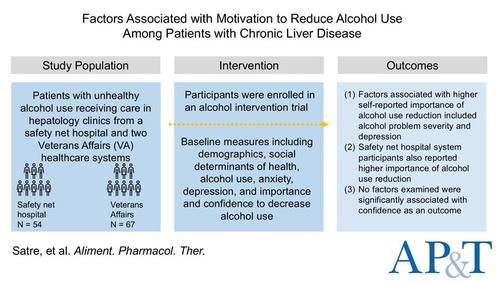当前位置:
X-MOL 学术
›
Aliment. Pharm. Ther.
›
论文详情
Our official English website, www.x-mol.net, welcomes your
feedback! (Note: you will need to create a separate account there.)
Factors Associated With Motivation to Reduce Alcohol Use Among Patients With Chronic Liver Disease
Alimentary Pharmacology & Therapeutics ( IF 6.6 ) Pub Date : 2024-11-11 , DOI: 10.1111/apt.18387 Derek D. Satre, Dhweeja Dasarathy, Steven L. Batki, Michael J. Ostacher, Hannah R. Snyder, William Hua, Priti Parekh, Amy M. Shui, Ramsey Cheung, Alexander Monto, Robert J. Wong, Jennifer Y. Chen, Meimei Liao, Michele Tana, Po‐Hung Chen, Christina G. Haight, Taylor Fakadej, Mandana Khalili
Alimentary Pharmacology & Therapeutics ( IF 6.6 ) Pub Date : 2024-11-11 , DOI: 10.1111/apt.18387 Derek D. Satre, Dhweeja Dasarathy, Steven L. Batki, Michael J. Ostacher, Hannah R. Snyder, William Hua, Priti Parekh, Amy M. Shui, Ramsey Cheung, Alexander Monto, Robert J. Wong, Jennifer Y. Chen, Meimei Liao, Michele Tana, Po‐Hung Chen, Christina G. Haight, Taylor Fakadej, Mandana Khalili

|
Background and AimsAlcohol use is prevalent among hepatology clinic patients with chronic liver disease (CLD). We explored factors associated with the importance and confidence dimensions of motivation to reduce drinking.MethodsParticipants (N = 121) with unhealthy alcohol use (i.e., over NIH guidelines) receiving care in hepatology clinics from a safety‐net hospital (SN, N = 54) and two Veterans Affairs Healthcare Systems (VA, N = 67) were enrolled in an alcohol intervention trial from March 2022 through October 2023. Baseline assessments included Generalised Anxiety Disorder (GAD‐7), Patient Health Questionnaire (PHQ‐8), Alcohol Use Disorders Identification Test (AUDIT), COVID‐19 stress; and measures of importance and confidence to decrease alcohol use (readiness rulers, scales of 1–10). Liver disease aetiology and severity were extracted from electronic health records. We performed multivariable linear regression models with forward selection to assess pre‐specified variables' associations with importance and confidence.ResultsThe sample was 84% male, 40% Latino, 31% White, 18% Black and 11% other races; median age was 61 years. Median (Q1–Q3) AUDIT score was 16 (12–24), importance was 9 (6–10) and confidence was 8 (5–9). On multivariable analysis, VA site (vs. SN) participants had a 0.97‐point lower importance score (p = 0.02); higher symptoms of depression (PHQ‐8 score ≥ 10 vs. < 10) and AUDIT scores (for each point increase) were associated with higher importance score (estimates 1.2 and 0.08, p < 0.05, respectively). Liver disease aetiology and severity were not significantly associated with outcomes.ConclusionsDepression, alcohol problem severity and treatment site may influence motivation to reduce alcohol use and could inform future hepatology‐based interventions.
中文翻译:

与慢性肝病患者减少饮酒动机相关的因素
背景和目的酒精使用在患有慢性肝病 (CLD) 的肝病临床患者中很普遍。我们探讨了与减少饮酒动机的重要性和置信度维度相关的因素。方法2022 年 3 月至 2023 年 10 月,在一家安全网医院 (SN, N = 54) 和两个退伍军人事务医疗保健系统 (VA, N = 67) 的肝病诊所接受不健康饮酒(即超过 NIH 指南)的参与者 (N = 121) 参加了酒精干预试验。基线评估包括广泛性焦虑症 (GAD-7)、患者健康问卷 (PHQ-8)、酒精使用障碍鉴定测试 (AUDIT)、COVID-19 压力;以及减少饮酒的重要性和信心的衡量标准(准备标尺,1-10 分)。从电子健康记录中提取肝病病因和严重程度。我们执行了具有前向选择的多变量线性回归模型,以评估预先指定的变量与重要性和置信度的关联。结果样本为 84% 男性、40% 拉丁裔、31% 白人、18% 黑人和 11% 其他种族;中位年龄为 61 岁。中位 (Q1-Q3) AUDIT 评分为 16 (12-24),重要性为 9 (6-10),置信度为 8 (5-9)。在多变量分析中,VA 站点 (vs. SN) 参与者的重要性得分低 0.97 分 (p = 0.02);较高的抑郁症状 (PHQ-8 评分 ≥ 10 vs. < 10) 和 AUDIT 评分 (每增加一个分数) 与较高的重要性评分相关 (估计值分别为 1.2 和 0.08,p < 0.05)。肝病病因和严重程度与结局无显著相关性。结论抑郁、酒精问题严重程度和治疗部位可能影响减少饮酒的动机,并可能为未来基于肝病学的干预措施提供信息。
更新日期:2024-11-11
中文翻译:

与慢性肝病患者减少饮酒动机相关的因素
背景和目的酒精使用在患有慢性肝病 (CLD) 的肝病临床患者中很普遍。我们探讨了与减少饮酒动机的重要性和置信度维度相关的因素。方法2022 年 3 月至 2023 年 10 月,在一家安全网医院 (SN, N = 54) 和两个退伍军人事务医疗保健系统 (VA, N = 67) 的肝病诊所接受不健康饮酒(即超过 NIH 指南)的参与者 (N = 121) 参加了酒精干预试验。基线评估包括广泛性焦虑症 (GAD-7)、患者健康问卷 (PHQ-8)、酒精使用障碍鉴定测试 (AUDIT)、COVID-19 压力;以及减少饮酒的重要性和信心的衡量标准(准备标尺,1-10 分)。从电子健康记录中提取肝病病因和严重程度。我们执行了具有前向选择的多变量线性回归模型,以评估预先指定的变量与重要性和置信度的关联。结果样本为 84% 男性、40% 拉丁裔、31% 白人、18% 黑人和 11% 其他种族;中位年龄为 61 岁。中位 (Q1-Q3) AUDIT 评分为 16 (12-24),重要性为 9 (6-10),置信度为 8 (5-9)。在多变量分析中,VA 站点 (vs. SN) 参与者的重要性得分低 0.97 分 (p = 0.02);较高的抑郁症状 (PHQ-8 评分 ≥ 10 vs. < 10) 和 AUDIT 评分 (每增加一个分数) 与较高的重要性评分相关 (估计值分别为 1.2 和 0.08,p < 0.05)。肝病病因和严重程度与结局无显著相关性。结论抑郁、酒精问题严重程度和治疗部位可能影响减少饮酒的动机,并可能为未来基于肝病学的干预措施提供信息。


















































 京公网安备 11010802027423号
京公网安备 11010802027423号